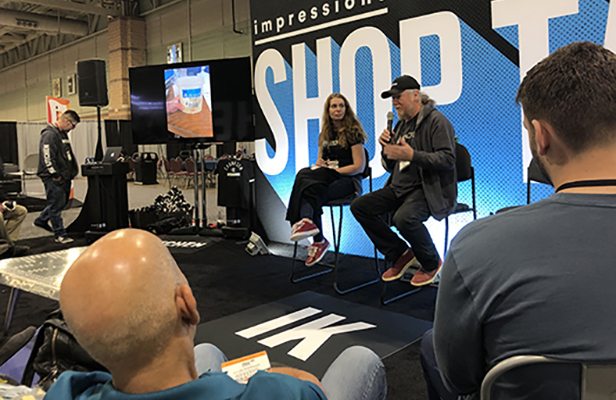News May 28, 2019
How to Prevent Dye Migration, Ghosting and Other Screen-Printing Evils
Rick Roth, an award-winning screen printer and president of Mirror Image Inc., shares advice.
Rick Roth, an award-winning screen printer and president of Pawtucket, RI-based Mirror Image Inc., runs a popular blog with Tom Davenport called The Ink Kitchen, which shares “real-world” knowledge of the decorated apparel industry. During ISS Atlantic City, Ink Kitchen hosted free talks on practical and visionary topics by decoration and garment experts.

Roth and Aimee Derouen, general manager at Mirror Image, discussed dye migration, ghosting and other evils in screen printing. “A lot of times if you design artwork from the ground up, it’s going to work out better,” Roth said. “If you design with a printing technique in mind, you’re going to get a soft, cheaper, faster result in the end.”
Dye Migration
Dye migration occurs when dye from polyester fibers bleed into the ink that is screen printed on the garment. The most common factor affecting dye migration is excessive heat, which causes the dye to release from the fibers. Roth says it can take a week or two, sometimes even a year for the dye to fully migrate.
“A lot of tri-blends have bleeding problems,” he said. “If you see the same kind of shirt coming from a different country than you’re used to, you better test it. It’s not like bigger companies have it down. Some of the worst ones we’ve had, for example, have been Nike shirts.”
Here’s how you test polyester fabric for dye migration, according to Roth. Put the fabric you are going to test on a transfer machine that is fully warmed up. Then apply a quarter-size drop of plasticizer (Mirror Image uses Rutland non-curable viscosity reducer). Lay a piece of white cloth on top of the plasticizer. Heat press the white fabric on top of the fabric you are testing. Do it at 320 degrees Fahrenheit for 30 seconds.
Then you check the white fabric. The more present the stain means the more severe the dye migration you will get when you print the fabric. “If you’re new to this, you think I’ll just print really thick white ink and it will stop the migration,” Roth said. “That’s actually the worst thing you can do. When you have thicker ink, you need more heat. It will just take longer and be worse in the end.”
To avoid dye migration when printing polyester, it might be wise to purchase an ink formulated specifically for printing on polyester, or to add a low-cure additive to the ink you intend to use. Inks that cure at lower temperatures are one of the key factors in avoiding dye migration.
“When I started printing, you used to just have cotton ink and low bleed ink,” Roth said. “They pretty much took care of everything. Those days are over. There’s no way some ink works on everything. You have to test it to know your product.”
Ghosting
This isn’t when you stop responding to somebody’s text messages. This is what happens when ink stains appear in your screen mesh.
“Many low-bleed inks have properties in them that will cause ghosting,” Roth said. “This is the stuff that keeps you up at night.”
Roth suggests thoroughly washing your screens, drying them and then exposing the inside of the screen to light. You should also clean your screens with standard, traditional screen printing chemicals rather than paint thinners. Make sure you clean the screen immediately after finishing printing to prevent ghosting as well. “You can also limit ghosting by stacking shirts in multiple piles instead of one tall stack where heat builds up,” Roth said.
Dryers
A common question that Roth gets is what temperature should you run your dryer at. After consulting with various textile mills, Roth has come to a conclusion: he has no idea.
“There are many different dryers: gas, electric, different heights, different air flow, different lengths,” he said. “Also, if you’re in Maine on a Monday morning and it’s all humid, I would say your shirt is going into the dryer at 32 degrees. If you’re in Arizona and there’s no humidity, your shirt is going in at 120 degrees on a Monday morning.”
Most people’s dryers are not calibrated, Roth says. Therefore, you have to test your dryer all the time. He suggests using temperature tape, a donut probe or a pyrometer “heat gun.”
